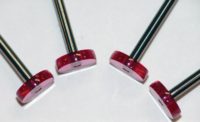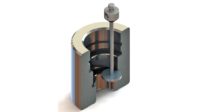Measurement
Custom CMM Styli
Consider what lollipops, pizzas and probe tips all have in common
















Most coordinate measuring machines (CMMs) are sold with a stylus kit containing an assortment of ruby ball styli and associated tools. Many CMM users soon realize that the standard assortment won’t meet all of their needs. Some part features simply can’t be accessed with these kit styli. Difficult-to-measure features may include ID grooves, features located deep inside a part, part undersides, and small radii. In these cases, a custom stylus may be helpful. But, what will it look like? How long will it take to manufacture? And how much will it cost?
Back of the Napkin
We call it the “back of the napkin.” A fax or email arrives with a freehand drawing of a “concept” stylus, sometimes with a sketch of the part feature it’s supposed to measure. Usually, the CMM operator is in a hurry to obtain the right probe tip for the job. Often the only thing standing in the way of successful measurement is the lack of a suitable stylus.
The concept’s feasibility and the materials needed to make it are the first concerns. Most CMM probing systems have stylus weight restrictions, so lightweight materials are usually employed. Deflection (bending) may be a concern depending on stylus length. Bend increases by a cubic function relative to length. In other words, doubling the length of the stylus increases the deflection eight times (23 = 8). This pesky physical property is frequently overlooked, and disqualifies many a wishful extra-long design.
Close collaboration between the CMM user and the manufacturer is required to arrive at a practical design. Ideas regarding materials, diameters and lengths are exchanged. Speedy delivery and cost are usually important, so off-the-shelf components are used whenever possible.
The Lollipop
Most CMM styli share a common design. We call it the “lollipop.” Like a lollipop, styli are usually made from three parts: ball, stem and base. The most common ball material is synthetic ruby. Synthetic ruby is chemically the same as the precious stone seen in fine jewelry. Synthetic ruby is a useful material for stylus balls due to its extreme hardness and relatively low coefficient of friction. Other suitable ball materials include silicon nitride, ceramic, tungsten carbide, zirconia, and hardened steel. The best choice depends on the application.
Stems are usually made from tungsten carbide, similar to the substance often used in cutting tools. Tungsten carbide’s stiffness makes it an excellent choice for CMM styli. Its weight, however, can be problematic. Tungsten carbide is four times heavier than alumina (ceramic) and nine times heavier than carbon fiber. Therefore, ceramic and carbon fiber are often chosen over tungsten carbide as the stem material when low weight is important. Both ceramic and carbon fiber are relatively stiff and have good strength-to-weight ratios.
Threaded bases are most often made from stainless steel, aluminum or titanium. As with stem material, the choice often comes down to weight. Although stainless steel is the least expensive material, it is three times heavier than aluminum and nearly twice the weight of titanium. Although most expensive, titanium is an excellent all-around choice thanks to its relatively low weight and superior thermal and wear characteristics. Low-cost stainless steel is the best choice for everyday measurement where thermal stability and wear are not so important. And mid-priced aluminum is often selected when stylus weight is critical.
So, now we have a feasible design, and we’ve selected the optimum materials for our lollipop (stylus). Next, CAD drawings of the concept are created and submitted for approval by the user. When everything is approved, and an order is issued, the drawings are submitted for production and assembly.
Making a Pizza
We often liken custom styli production to making a pizza. There are standard stylus designs, just as there are standard pizzas, like cheese and pepperoni. Often, however, a different combination is ordered. We maintain a full selection of ball, stem and base sizes and materials. Frequently, we’ll create a custom stylus from stock parts that haven’t been arranged in that particular order before. Much like a good pizzeria will combine your choice of crust, sauces and toppings for a one-of-a-kind meal while you wait, your special stylus can be assembled from stock parts in a few hours and shipped the same day.
Other custom styli are unique in every detail. A special base, special stem, and special ball size or configuration can all come together to create a stylus that is one-off and expensive to produce in small quantities. But if it offers the solution to a vexing part measurement, it’s often the most cost-effective means of keeping the job moving.
Probe of the Month
One of the most popular features on our website is the “Probe of the Month” photo gallery. Each month we feature a new stylus that we built to order during the previous month. We’ve built some crazy designs. We’re often asked, “What was that one used to measure?” or “How was this used?” The truth is that we usually have no idea what it’s intended to measure. This is a disappointing factor of making custom styli. In most instances, we don’t know what they do.
Some years ago, I was approached at a trade show by a screw-top container manufacturer. He pulled a water bottle screw-top lid from his pocket, sat it down on the table, and asked me how to measure an inner diameter that was flush with the surface inside the lid and behind the threads of the screw-top. Right there, we created a “back of the napkin” design for a wedge-shaped disk that just missed the surface and threads but still accessed the required ID. The prototype parts worked pretty well. With a few more tweaks, we had a good design. I’m told the custom stylus we designed that day is still in use there.
An ideal custom stylus design combines suitable physical characteristics for stiffness and wear resistance, optimum weight, quick manufacture, and, above all, effective measurement. All that can be a tall order considering the challenges many inspectors face with complex parts and barely accessible features. It’s important to keep an open mind when designing a custom stylus. We produce hundreds of unique stylus and associated tooling designs every year. It’s helpful for both user and manufacturer to collaborate on designs that have never before been produced. From our perspective, we can draw upon our years of experience with similar designs to suggest one that can get the job done with minimum cost and lead time. Of course, no one understands the measurement needs better than the client. Working together, it’s usually pretty easy to arrive at a design that suits everyone’s needs.
A Permanent Spot on the Menu
If it’s tasty, a unique pizza may find a permanent spot on the restaurant’s menu. We’ve produced custom designs that are now featured in our catalog as part of our standard product offering. Sometimes the best solution to a measurement challenge is the genesis for a stylus design with broad appeal.
A special CMM stylus can embody a minor modification to an existing product, or require a completely new design. A custom stylus can be a small as a whisker, or nearly as large as a golf club. They all share a common purpose, namely, to get the job done. Lollipops, pizzas, and probe tips: they have more in common than you might think.
Looking for a reprint of this article?
From high-res PDFs to custom plaques, order your copy today!













